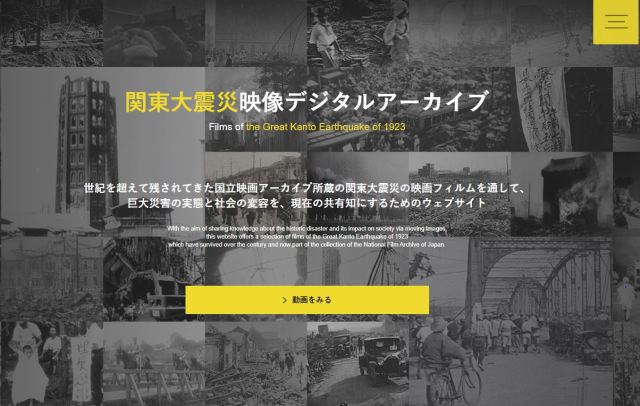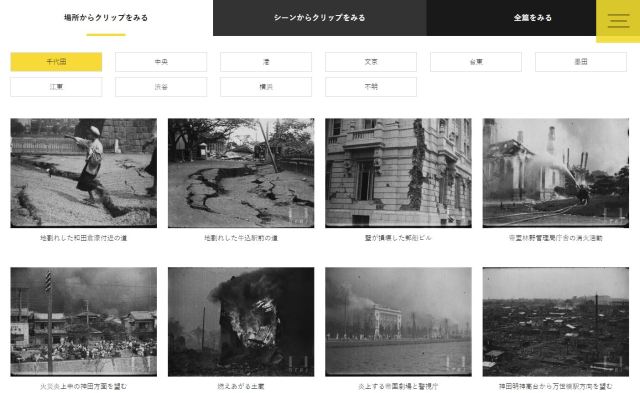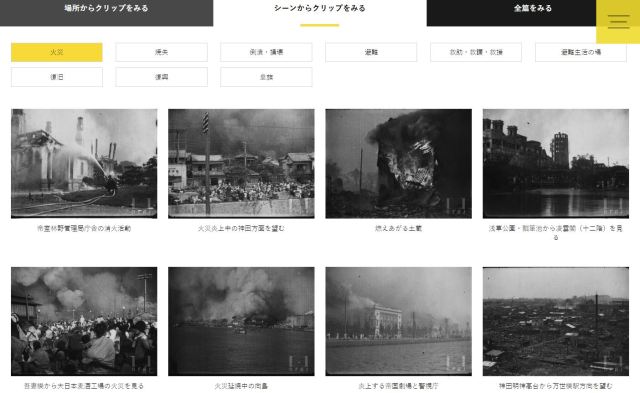
A new publicly accessible website compiles contemporary footage of the deadliest natural disaster in Japanese history into a 64-minute film.
It’s strange to think that we’re only two years away from the centennial anniversary of the Great Kanto Earthquake of Japan. The earthquake, which struck at 11:58 a.m. on September 1, 1923 (the 12th year of the Taisho era by the Japanese calendar), also triggered a tsunami and landslides throughout the capital region. Most destructive, however, were the firestorms that ravaged Tokyo, Yokohama, and the surrounding communities in the wake of the quake due to the fact that many stoves were lit for lunch at the time. This natural disaster remains the deadliest in Japanese history (roughly five times more so than the devastating 2011 Tohoku Earthquake and Tsunami) with over 105,000 casualties and two million homes destroyed, leaving a profound impact on society for years afterwards.
On August 31, the National Film Archive of Japan, together with the National Institute of Informatics and supervised by Japan’s Ministry of Education, Culture, Sports, Science, and Technology, launched a special website called Films of the Great Kanto Earthquake of 1923. Anyone with an Internet connection can now gain an intimate, first-hand view into scenes of the terrible destruction wreaked by the quake as well as humanity banding together in the aftermath in rare contemporary footage.
Since the text for the site (which can be found here) remains Japanese-only at this time, here are a few navigation tips. From the top page, click on the yellow menu button in the upper-right corner to select how you would like the video clips to be organized. You can choose from the following options:
● View clips by place (場所からクリップをみる)
● View clips by type of scene (シーンからクリップをみる)
● View full compilation (全篇をみる) (a 64-minute compilation based on a documentary film released shortly after the quake).
If you select “View clips by place,” you’ll be presented with a short list of what are now some of the 23 wards of Tokyo including Chiyoda, Chuo, Minato, Bunkyo, Taito, Sumida, Koto, and Shibuya, as well as Yokohama and a “place unknown” category:
▼ Places are listed from left to right in the order noted above.
Meanwhile, if you select “View clips by type of scene,” you’ll be presented with a variety of scene types to choose from including fires, destruction caused by fire, collapsed structures/destruction, taking shelter, relief/aid/rescue, life in an evacuation center, reconstruction, revival, and the imperial family.
▼ Scene types are listed from left to right in the order noted above.
The National Film Archive plans to publicly release all footage in its possession related to the 1923 Great Kanto Earthquake by 2023 to mark 100 years since the disaster. In the meantime, the quake still remains in the collective consciousness as September 1 has been known as Disaster Prevention Day in Japan since 1960–a day on which all kinds of emergency drills are practiced at schools and workplaces in an effort to lessen the loss of life if a natural disaster were to strike again.
Source: National Film Archive of Japan via Japaaan
Images: National Film Archive of Japan
● Want to hear about SoraNews24’s latest articles as soon as they’re published? Follow us on Facebook and Twitter!



 Edo-era illustrated records show the disasters that have plagued Japan throughout its history
Edo-era illustrated records show the disasters that have plagued Japan throughout its history Five years on, Google Maps updates images of areas affected by 2011 earthquake and tsunami
Five years on, Google Maps updates images of areas affected by 2011 earthquake and tsunami Women speak out about sexual violence after Great East Japan Earthquake
Women speak out about sexual violence after Great East Japan Earthquake Ancient Japanese literary works are now yours to download at the click of a button
Ancient Japanese literary works are now yours to download at the click of a button Is Japan about to be rocked by a big earthquake?
Is Japan about to be rocked by a big earthquake? Foreigner’s request for help in Tokyo makes us sad for the state of society
Foreigner’s request for help in Tokyo makes us sad for the state of society Japanese city loses residents’ personal data, which was on paper being transported on a windy day
Japanese city loses residents’ personal data, which was on paper being transported on a windy day Akihabara pop-up shop sells goods made by Japanese prison inmates
Akihabara pop-up shop sells goods made by Japanese prison inmates Harajuku Station’s beautiful old wooden building is set to return, with a new complex around it
Harajuku Station’s beautiful old wooden building is set to return, with a new complex around it French Fries Bread in Tokyo’s Shibuya becomes a hit on social media
French Fries Bread in Tokyo’s Shibuya becomes a hit on social media We tried Korea’s way-too-big King Tonkatsu Burger at Lotteria 【Taste Test】
We tried Korea’s way-too-big King Tonkatsu Burger at Lotteria 【Taste Test】 Ghibli Park now selling “Grilled Frogs” from food cart in Valley of Witches
Ghibli Park now selling “Grilled Frogs” from food cart in Valley of Witches You Can Have Your Very Own Whale Party on iPhone Messages In Just a Few Simple Steps
You Can Have Your Very Own Whale Party on iPhone Messages In Just a Few Simple Steps Red light district sushi restaurant in Tokyo shows us just how wrong we were about it
Red light district sushi restaurant in Tokyo shows us just how wrong we were about it 11 different ways to say “father” in Japanese
11 different ways to say “father” in Japanese McDonald’s new Happy Meals offer up cute and practical Sanrio lifestyle goods
McDonald’s new Happy Meals offer up cute and practical Sanrio lifestyle goods Japanese ramen restaurants under pressure from new yen banknotes
Japanese ramen restaurants under pressure from new yen banknotes Studio Ghibli releases new action figures featuring Nausicaä of the Valley of the Wind characters
Studio Ghibli releases new action figures featuring Nausicaä of the Valley of the Wind characters New private rooms on Tokaido Shinkansen change the way we travel from Tokyo to Kyoto
New private rooms on Tokaido Shinkansen change the way we travel from Tokyo to Kyoto Tokyo Tsukiji fish market site to be redeveloped with 50,000-seat stadium, hotel, shopping center
Tokyo Tsukiji fish market site to be redeveloped with 50,000-seat stadium, hotel, shopping center All-you-can-drink Starbucks and amazing views part of Tokyo’s new 170 meter-high sky lounge
All-you-can-drink Starbucks and amazing views part of Tokyo’s new 170 meter-high sky lounge Beautiful Ghibli sealing wax kits let you create accessories and elegant letter decorations【Pics】
Beautiful Ghibli sealing wax kits let you create accessories and elegant letter decorations【Pics】 Studio Ghibli releases Kiki’s Delivery Service chocolate cake pouches in Japan
Studio Ghibli releases Kiki’s Delivery Service chocolate cake pouches in Japan New definition of “Japanese whiskey” goes into effect to prevent fakes from fooling overseas buyers
New definition of “Japanese whiskey” goes into effect to prevent fakes from fooling overseas buyers Our Japanese reporter visits Costco in the U.S., finds super American and very Japanese things
Our Japanese reporter visits Costco in the U.S., finds super American and very Japanese things Studio Ghibli unveils Mother’s Day gift set that captures the love in My Neighbour Totoro
Studio Ghibli unveils Mother’s Day gift set that captures the love in My Neighbour Totoro New Japanese KitKat flavour stars Sanrio characters, including Hello Kitty
New Japanese KitKat flavour stars Sanrio characters, including Hello Kitty More foreign tourists than ever before in history visited Japan last month
More foreign tourists than ever before in history visited Japan last month New Pokémon cakes let you eat your way through Pikachu and all the Eevee evolutions
New Pokémon cakes let you eat your way through Pikachu and all the Eevee evolutions Sales of Japan’s most convenient train ticket/shopping payment cards suspended indefinitely
Sales of Japan’s most convenient train ticket/shopping payment cards suspended indefinitely Sold-out Studio Ghibli desktop humidifiers are back so Totoro can help you through the dry season
Sold-out Studio Ghibli desktop humidifiers are back so Totoro can help you through the dry season Japanese government to make first change to romanization spelling rules since the 1950s
Japanese government to make first change to romanization spelling rules since the 1950s Ghibli founders Toshio Suzuki and Hayao Miyazaki contribute to Japanese whisky Totoro label design
Ghibli founders Toshio Suzuki and Hayao Miyazaki contribute to Japanese whisky Totoro label design Doraemon found buried at sea as scene from 1993 anime becomes real life【Photos】
Doraemon found buried at sea as scene from 1993 anime becomes real life【Photos】 Tokyo’s most famous Starbucks is closed
Tokyo’s most famous Starbucks is closed One Piece characters’ nationalities revealed, but fans have mixed opinions
One Piece characters’ nationalities revealed, but fans have mixed opinions We asked a Uniqlo employee what four things we should buy and their suggestions didn’t disappoint
We asked a Uniqlo employee what four things we should buy and their suggestions didn’t disappoint Princesses, fruits, and blacksmiths: Study reveals the 30 most unusual family names in Japan
Princesses, fruits, and blacksmiths: Study reveals the 30 most unusual family names in Japan Stay safe on the cheap with a disaster preparedness kit put together at the 100-yen shop
Stay safe on the cheap with a disaster preparedness kit put together at the 100-yen shop Travel through time from Shibuya
Travel through time from Shibuya Japan makes card game to help kids raise disaster prevention awareness
Japan makes card game to help kids raise disaster prevention awareness Typhoon Jebi hits Japan, blows away cars, roofs, and building facades 【Pics & Videos】
Typhoon Jebi hits Japan, blows away cars, roofs, and building facades 【Pics & Videos】 Nintendo’s god-tier customer service continues as they offer free repairs for Noto earthquake victims
Nintendo’s god-tier customer service continues as they offer free repairs for Noto earthquake victims Yamazaki Bakery once again donates bread to evacuation centers at almost inhuman speeds
Yamazaki Bakery once again donates bread to evacuation centers at almost inhuman speeds Embrace the literary and the historical with traditional Japanese artwork as your Zoom background
Embrace the literary and the historical with traditional Japanese artwork as your Zoom background Two of Japan’s biggest chains travel to disaster-stricken Kumamoto to hand out free beef bowls
Two of Japan’s biggest chains travel to disaster-stricken Kumamoto to hand out free beef bowls Emotional photos of Fukushima are turned into a moving tribute in gorgeous joint project【Video】
Emotional photos of Fukushima are turned into a moving tribute in gorgeous joint project【Video】 NHK slips touching hidden message into TV listings on March 11
NHK slips touching hidden message into TV listings on March 11 North Korea-U.S. tensions spark interest in Japanese government’s J-Alert warning system
North Korea-U.S. tensions spark interest in Japanese government’s J-Alert warning system Japanese government plans removal of around 2,485 miles’ worth of overhead power lines
Japanese government plans removal of around 2,485 miles’ worth of overhead power lines World famous shadow artist shines a light on Tohoku relief【Art】
World famous shadow artist shines a light on Tohoku relief【Art】 One man’s epic journey around the world… on a unicycle
One man’s epic journey around the world… on a unicycle “Disaster”: 2018 Kanji of the Year unveiled by Buddhist monk at Kiyomizudera temple in Kyoto
“Disaster”: 2018 Kanji of the Year unveiled by Buddhist monk at Kiyomizudera temple in Kyoto
Leave a Reply